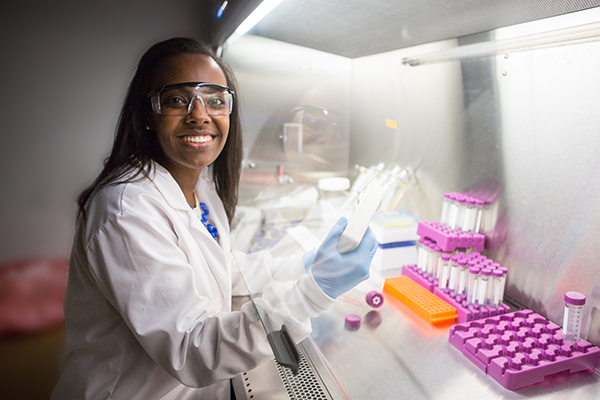Ailon Haileyesus

A bleak hospital ward in Mozambique sparked Ailon Haileyesus’ determination to improve health care in developing countries. She visited the hospital while in high school, one of several service trips that she has made to sites around the world. “People were lying in beds with no sheets, and there was no electricity, no air conditioning, and it was really hot,” she recalled. “It was mind blowing to see that!”
Ailon's parents grew up in Ethiopia, where health care is similarly compromised, and she still has many relatives there, so the issue strikes close to home: “Everyone deserves equal rights in health care,” she said firmly.
Ailon plans a career developing low-cost biomedical devices that can deliver test results within minutes in demanding environments. She’s launching that effort by conducting research on the effects of traumatic brain injury in a very high-tech lab at the UA’s Engineering Research Center. Together with mentor Kartik Balachandran, an assistant professor of biomedical engineering, and graduate student Nasya Sturdivant, Ailon is studying astrocytes, the primary neuron-supporting cells in nervous tissue.
The team is focusing on TRPV4, a membrane protein channel that converts mechanical force into electrical stimuli. These electrical signals in turn open up channels that release calcium into brain tissue, which can disrupt the brain and lead to cell death. “The more we know about the calcium signaling, the more research can be done to reduce the amount of calcium released into cells,” Ailon said.
Ailon starts her work in the cell culture room, growing astrocytes in an incubator set at body temperature. She periodically washes the sample to remove waste and feeds it with a special solution. Then, she transfers the cells to a membrane cradled in plastic tubing and stretches the sample to mimic brain trauma. Immediately after stretching the sample, she measures calcium signaling using a fluorescence instrument. Ailon also measures protein expression, using the Western Blot technique, to determine how many of the TRVP4 channels are present before and after force is applied.
“These are difficult experiments to do, because the cells need to be kept alive,” Kartik Balachandran said. “You have to be quick, because the cells get unhappy quickly, and start to die.” Balachandran’s team is already using this system to test acetazolamide (AZA), a drug currently used to treat altitude sickness and brain injury. “More than anything, this system is an effective platform to test drugs that treat brain injury,” he said.
Ailon did get a hands-on opportunity to develop a low-cost diagnostic device last summer, thanks to a Harvard-Amgen scholarship. She worked in the lab of George Whitesides, a chemistry professor at Harvard who leads in the development of paper-based diagnostic tools. Her project focused on printing wax channels on color-sensitive paper, so that a single biological sample could be used to test for the presence of several important markers, such as proteins, glucose and liver enzymes. “You can use the simplest materials, like paper, to create a useful screening tool,” Ailon said. “It confirms my desire to create medical devices that could be used in developing countries.”
*** Broken a:222152 honorscollege: Meet the Students ***